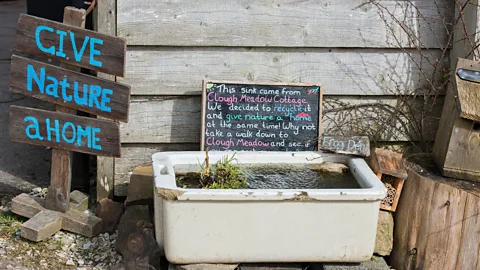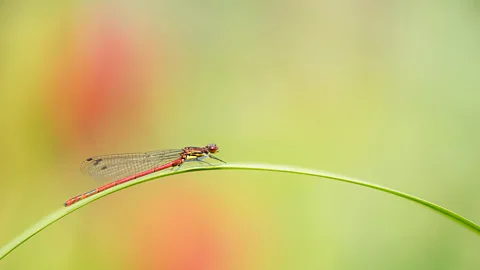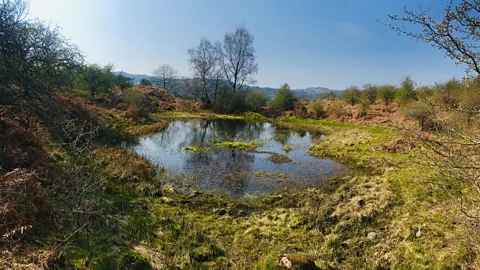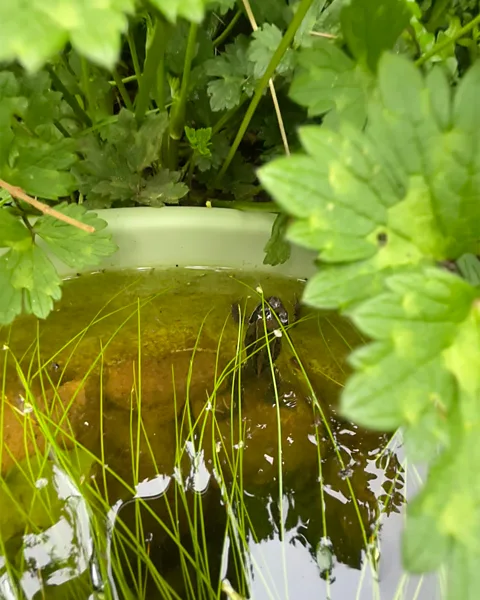Mini ponds are 'tiny universes' of biodiversity for gardens and windowsills
 Heather Stuckey
Heather StuckeyWhen the BBC's Katherine Latham made a pond with just a plant pot, some rocks and a few native pond plants, she was amazed at the speed wildlife moved in.
"I hope we get frogs and newts, and animals of all kinds," said my son, 11-year-old Billy, as we carefully prized apart the roots of a pond plant we were trying to split into three, before plopping them into the water.
It was a sunny Sunday at the beginning of March, in my back garden in Gloucestershire, UK, and my children and I were making three mini ponds. We'd taken three cheap plastic plant pots and dug two of them into the ground, and stood the third surrounded by plants. When then lined them with rocks and filled them with water, rocks and native pond plants.
We were hopeful wildlife would come but, at the same time, apprehensive that – in the midst of a biodiversity crisis – nothing would find its way to our little oases. Then, just one week later, we noticed spiders and insects had begun to visit. Ants were crawling about the edge. Hover flies, bumblebees and ladybirds flittered nearby.
 Ben Andrew
Ben Andrew"Ponds are absolute biodiversity hotspots – in terms of both the range and density of species that use them. After you fill a hole in the garden with water, wildlife will come – very, very quickly. It's astonishing how quickly it comes," says Adrian Thomas, an expert on gardening for wildlife at the Royal Society for the Protection of Birds and author of book Gardening for Wildlife.
Ponds, he says, offer a mix of habitat types. "Within a pond you have cool bits, open water, shallow bits, the margins around the outside. You get this ecological principle known as the edge effect, where different habitats butt up against each other. It might be easy to think that you've got just two habitats – pond and not pond – but actually, you've got all these interlocking microhabitats." The result, he says, is a "diversity of life that so is much greater than in any other part of the garden".
Species to look out for could include the common frog, smooth newt, water beetles, diving beetles, dragonfly nymphs and caddisfly larvae. Not to mention birds and bats. However, for the amphibians particularly, we might have to be lucky. Worldwide, the situation is dire. A 2023 report, compiled by more than 100 scientists, found that global amphibian populations are deteriorating, with over 40% at risk of extinction in the coming decades. This is the highest of any major animal group on the conservation Red List, with disease, climate change and habitat destruction driving their decline.
Sign up to Future Earth
Sign up to the Future Earth newsletter to get essential climate news and hopeful developments in your inbox every Tuesday from Carl Nasman. This email is currently available to non-UK readers. In the UK? Sign up for newsletters here.
Habitat recreation, then, is one way we can help. Ponds support more biodiversity than larger waterbodies, even rivers and lakes. They are home to two-thirds of all freshwater species, and provide vital services for pollinators, birds, bats and other mammals too. Even a small body of water like a pot or bucket could soon attract wildlife and, according to the Freshwater Habitats Trust, creating new ponds is one of the "simplest and most effective ways to protect freshwater wildlife". Read more about how wildlife finds garden ponds in this article by Chris Baraniuk.
Our gardens are not isolated islands, but a sprawling network of green spaces. If we add ponds into the mix, we can create blue corridors that connect pond to pond, lake to lake, and river to river – all the way to the edge of the ocean.
Take my own garden in Gloucestershire, not far from the wooded banks of the River Wye or from the tidal mudflats of the River Severn. Imagine the network of waterways if each garden between these rivers had a pond.
Top tips for making your own mini pond
• Fill your pond with rain water, as tap water often has high levels of dissolved nitrogen and phosphorus.
• There's no need to top up with water, even in dry periods, as some animals like newts can benefit from varying water levels.
• Make sure there is a shallow edge so that creatures can crawl in and out of the water.
• Don't add fish. They will likely gobble up any invertebrates or tadpoles.
• Choose plenty of native pond plants, to avoid the spread of non-native invasive plant species.
• Don't take frogspawn from elsewhere to add to your pond as this may spread disease.
• Consider removing solid fencing around your garden, which can hamper movement of some species.
• Be patient. "A pond takes time to develop," says Thomas, "to settle itself, to grow plants and wildlife, to come to nature's balance."
"Ponds they are one of the earliest habitat types on the planet," says Naomi Ewald, technical director at the Freshwater Habitat Trust, a non-profit in the UK. "Darwin even hypothesised that life began in a pond. We are talking about a habitat that's been here forever, and life has evolved over millions of years to live in those environments. From the tiniest algae and the smallest life – most of which we haven't even begun to identify – to insects and plants, and then all those higher animals on top. You can find almost every single taxonomic group in a pond."
Networks of ponds – or "pondscapes" – are crucial for biodiversity. These small water bodies can be permanent or seasonal, natural or man-made, and provide habitats for many endemic, threatened or rare species. In Europe alone, ponds have been found to support up to 70% of regional freshwater species.
More like this:
Ponds can provide predator-free environments, as well as refuge from disease and invasive species. They also boost pollination and allow nutrients to flow to adjacent ecosystems. Ponds also act as "stepping-stone habitats", providing connectivity between freshwater sites, and enabling the dispersal of species across the landscape.
While cities spread as urban populations burgeon, the negative impact of urbanisation on biodiversity can be buffered by these blue corridors, says one 2021 study, preventing biodiversity loss and reducing the risk of local extinctions. The researchers found that to preserve biodiversity in urban ponds, combining blue with green spaces could enhance this connectivity.
"There's huge potential," says Ewald. "I've only got a small garden and live in a very urban area. I've got container ponds in my back garden – which are just teeming with life. They've got dragonflies, water beetles, snails. They are an oasis of wildlife in the urban environment." If people create homes for wildlife in their gardens, she says, "they will be playing a very active role in bringing back that freshwater landscape" – and wildlife will arrive.
 Freshwater Habitats Trust
Freshwater Habitats TrustUrban ponds allow movement of wildlife throughout the urban matrix. The bigger the better, says one recent study, but small is better than none. In fact, research shows small water bodies attract as many small species as larger water bodies do, and garden water sources "present a significant conservation opportunity" when it comes to urban wildlife.
So, even if the only outdoor space you have is a window box, you can make your own mini pond that, within weeks, could be full of life and part of the wider "pondscape".
Ponds come with other benefits too, including water purification, flood mitigation, and even climate regulation. Although ponds can act as both carbon sinks and sources, they have been found to hold up to 30 times more carbon in their sediments than other habitat types – including peatlands, woodlands and grasslands – and can store higher concentrations of greenhouse gases such as carbon dioxide (CO2) and methane (CH4) than larger lakes and oceans.
But ponds are in trouble. Due to their small size ponds are particularly vulnerable to anthropogenic stressors, including climate change, pollution and habitat degradation.
"Go back 3,000 years and the landscape would have been dotted with natural ponds – peat bogs, flood plains, oxbow lakes…" says Thomas. "Today, the ponds you might encounter are often garden ponds, farm ponds, fishing ponds, or moats around castles. So many of the ponds in existence today are human in origin."
Carbon Count
The travel emissions it took to report this story were 0kg CO2. The digital emissions from this story are an estimated 1.2g to 3.6g CO2 per page view. Find out more about how we calculated this figure here.
Around 1000BC, before our ancestors began draining the land, at least a quarter of Britain was wetlands. The US, too, used to be covered in marshes, ponds and bogs. When Europeans arrived on the continent in the early 17th Century, what was to become the United States of America had around 221 million acres of wetlands.
By the 1980s this had more than halved. Numbers of ponds worldwide, too, are dwindling. In the past century, at least 50% of ponds in both the UK and Europe have disappeared from the landscape. And in some regions including the Netherlands, Switzerland and Germany, only 10% of ponds remain. This loss of natural ponds, and the associated decline of landscape connectivity, is resulting in "profound negative consequences" for biodiversity.
 Billy Latham
Billy LathamBack in our garden, we were visiting our mini ponds daily, excited to see what might have made its home there. We practiced patience – as Thomas advised – which was difficult as at first the ponds grew thick with algae. But then, in just a few days, the waters cleared again. In week two, we were somewhat surprised to find aquatic life – water fleas and mosquito larvae darting about under the surface.
On the Sunday afternoon of week three, I heard squeals of delight and my children came sprinting in from the garden unable to contain their excitement. They had found a fully grown common frog, which they affectionately named "Froggo". Now, we are on tenterhooks, waiting to see if we get any frogspawn.
Our mini-pond journey has been a magical experience. These tiny universes, teeming with life within just a short space of time, are a source of joy and wonder – and I for one feel privileged to witness the biodiversity boost that comes with just a simple pot of water.
--
If you liked this story, sign up for The Essential List newsletter – a handpicked selection of features, videos and can't-miss news, delivered to your inbox twice a week.
